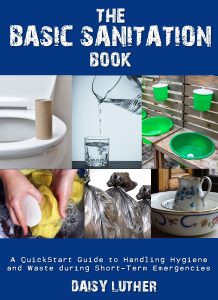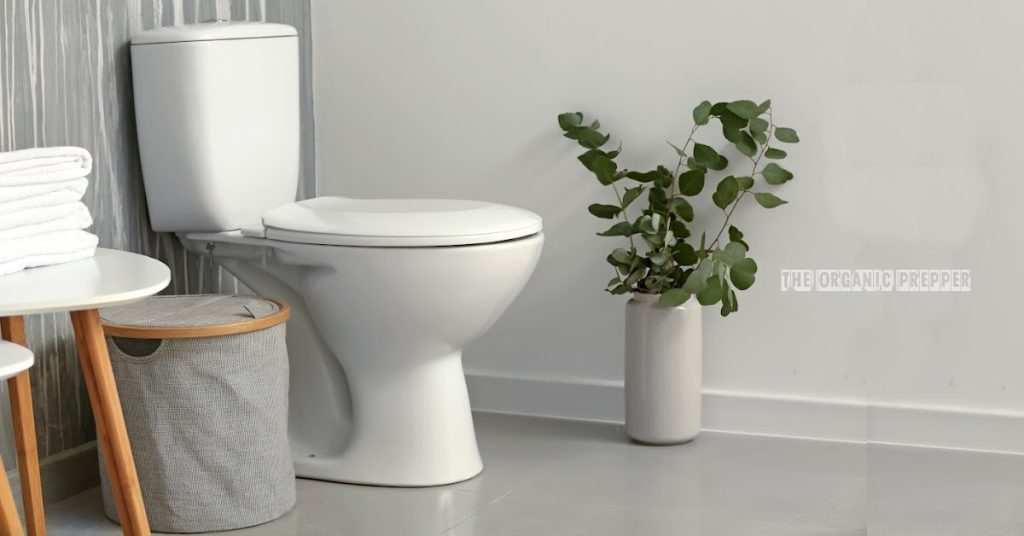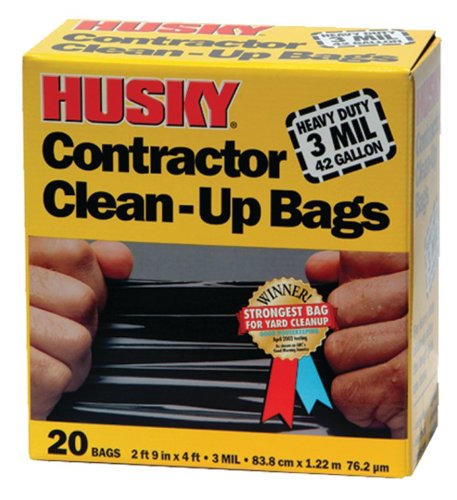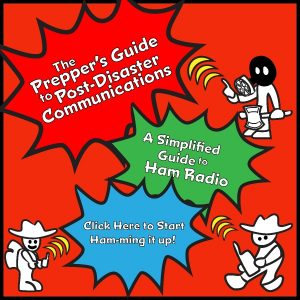If you're new here, you may want to subscribe to my RSS feed. Thanks for visiting!
This article contains an excerpt from The Basic Sanitation Book
What do you do during an emergency when the toilet won’t flush? If you’re prepped for it, you can easily make a kitty litter toilet with very limited supplies. Read on for instructions and city sanitation motivation.
Did you ever stop to put some thought into the glorious flushing power of your toilet? It’s one of those things we in modern society take for granted. We use the restroom, then we flush, wash our hands, and forget it.
But during extreme scenarios, this isn’t always so easy. When researching my book, The Prepper’s Water Survival Guide, I spent a lot of time reading about water, sanitation, and waterborne illness. These issues are all closely linked, and it’s vital to find solutions.
If you’re on a septic system, you have a safe place for your waste to go during most types of disasters, assuming you have additional water on hand for flushing.
But, in the city, on a public sewer system, there exists the possibility that a situation could arise during which flushing is not an option. Do you remember during the aftermath of Superstorm Sandy when residents of high-rise apartment buildings couldn’t flush because the city water system was down? There were numerous reports that people were so desperate that they were defecating in the hallways. They quoted a resident of a senior apartment complex, Anna Hay, who said, “They can’t go upstairs to go to the bathrooms. Where are they going to go? They’re walking all around for a place to go. There’s nowhere to go in this area.” (source)
With some very small and inexpensive preparations, it doesn’t have to come down to that. Just having a portable toilet is not enough for good hygiene and safety. If you live in an urban area, going outside to do your business may not be an option. You have to figure out a way to take care of this indoors while maintaining the health of your environment.
As a former city prepper, I’ve been through a few situations during which our toilets were inoperable due to a local disaster. Luckily, I had the supplies on hand to create a kitty litter box for people, so my children and I were able to stay in the safety of our home without risking illness due to poor sanitation.
Get this information and more to download to your device or USB with The Basic Sanitation Book, on sale now.
How to Make a Kitty Litter Potty
Here’s all you need to make a litter box for people:
- Kitty Litter (For this purpose, get a scented one)
- Extremely heavy garbage bags (Get the kind that contractors use and do NOT skimp on the garbage bags, whatever you do)
- Your toilet or this portable one
Hopefully, you realized you weren’t going to be able to flush before using your toilet. If there is waste sitting in your toilet, you’re going to need to get rid of it. Not fun, I know, but if it sits there for several days, it’s going to smell terrible, even with the lid down. To get rid of it, you’ll need to have a bag set up with a bit of kitty litter in it. Then, use a cheap dollar store utensil like a slotted spoon to fish out the poop. Try not to hurl because that’s just something else you’ll have to dispose of. Get rid of the slotted spoon because you will NEVER want to stir beans with that one again. You’d have flashbacks.
Now that this is out of the way, you have two options. You can line your toilet and continue to use it following the directions below, or you can switch to the luggable loo, which is basically just a 5-gallon bucket equipped with a toilet seat and a lid. The process is the same for either one.
If you’re using your toilet, turn the water off to the tank. (The knob for this should be on the wall at the back of it.)
 Line the toilet with a garbage bag. Let me repeat: DO NOT GO CHEAP ON THE GARBAGE BAGS! You want to use the best ones you can get your hands on. The ones for contractors are designed to carry very heavy loads. (There’s a horrible pun that I’m resisting making right now.) The last thing you want is for a bag full of human waste to break as you are carrying it out of your house. Put the bag in the bowl, then pull the top of the bag down over the edges of the toilet. Put the seat down to hold the bag into place.
Line the toilet with a garbage bag. Let me repeat: DO NOT GO CHEAP ON THE GARBAGE BAGS! You want to use the best ones you can get your hands on. The ones for contractors are designed to carry very heavy loads. (There’s a horrible pun that I’m resisting making right now.) The last thing you want is for a bag full of human waste to break as you are carrying it out of your house. Put the bag in the bowl, then pull the top of the bag down over the edges of the toilet. Put the seat down to hold the bag into place.
If you’re using the Loo, line it with a garbage bag. Same as above, put the bag into the bucket, then pull the top edges down the side of the bucket. Put the seat down to hold the bag into place.
From here, the steps are the same.
Put a handful of kitty litter into the bottom of the bag to start off. Although I don’t usually like scented products, this is an extreme scenario. Trust me, you want scent. Put the bucket of kitty litter beside the toilet and put a scoop in it (about a 1 cup scoop)
Now you can use the bathroom. When someone has to go, they should do their business then toss a little bit of kitty litter on top of it. Don’t go crazy – just a cup of litter should do the trick. Remember, it’s designed to cover the smell of poop. Put the lid down on the toilet or loo after you use it.
business then toss a little bit of kitty litter on top of it. Don’t go crazy – just a cup of litter should do the trick. Remember, it’s designed to cover the smell of poop. Put the lid down on the toilet or loo after you use it.
Don’t let it get too heavy before taking it outside. For the love of all things cute and fluffy, watch the weight of your human litter. It will soak up urine and become heavy clumps of clay. (Anyone who has ever changed a litter box knows how heavy it can get.) Remove the bag and discard it outside before it becomes a) too heavy to handle or b) heavy enough to cause the bag to break. If you’re using good quality garbage bags, “a” is more likely than “b”. Most likely, you’ll need to take the bag out once per day. It could be more if you have a large family or if someone is ill and making abundant use of the potty.
This is obviously not a solution for a very long-term situation because you would have to dispose of the bags of poop. However, in a shorter-term scenario, you should be able to load the bags into a garbage can outside and deal with them when services are restored.
Be certain to wash your hands well after dealing with human waste. Although I’m not usually a fan of hand sanitizer, in these kinds of situations, I strongly suggest the use of it. Your family could become extremely ill if good hand hygiene and waste management techniques are not practiced.
Resources
Check out these additional resources for more information on water and sanitation in an emergency.
Short term:
Longer term:
The Prepper’s Water Survival Guide: Harvest, Treat, and Store Your Most Vital Resource
About Daisy
Daisy Luther is a coffee-swigging, adventure-seeking, globe-trotting blogger. She is the founder and publisher of three websites. 1) The Organic Prepper, which is about current events, preparedness, self-reliance, and the pursuit of liberty; 2) The Frugalite, a website with thrifty tips and solutions to help people get a handle on their personal finances without feeling deprived; and 3) PreppersDailyNews.com, an aggregate site where you can find links to all the most important news for those who wish to be prepared. Her work is widely republished across alternative media and she has appeared in many interviews.
Daisy is the best-selling author of 5 traditionally published books, 12 self-published books, and runs a small digital publishing company with PDF guides, printables, and courses at SelfRelianceand Survival.com You can find her on Facebook, Pinterest, Gab, MeWe, Parler, Instagram, and Twitter.















35 Responses
I remember about a year or two ago when I posted to FB about this and my oldest son, who is going to turn 50 at the end of the year, laughed at me and said that toilets don’t run on electricity, lol! Too bad he still isn’t on FB anymore as I wonder what he thinks about toilets and flushing these days.
Incinetating Toilets do use electricity. There are two types. All electric or gas and electric. On the all electric model, electricity operated the heating element and exhaust fan. On the gas/electric models electricity is used to ignite the gas jet, and for the exhaust fan.
These Toilets have been around since at least the 70s. A couple of popular resorts here in Colorado were built with those from the beginning in the guest cabins
The ash, left over, collects in a basin. By the time it’s done, it can be thrown out or used as fertilizer in a garden. Nothing pathogenic is left in the ash, and unless you know it’s incinerated fecal matter, it looks no different than wood ash.
In an emergency I used a 5 gallon bucket, contractors black trash bags and a pool noodle slit open lengthwise and cut to fit the bucket top. I added wood pellets (my heat source) to form up the contents and added baking soda to cut the smell. Kitty litter may have been faster but I live about 20 miles from the nearest store. Most years I go into winter with 2 tons of pellets and usually have a few left each year. My heating stove can burn pellets with a hopper or I can take it off and burn wood. I quit cutting and splitting wood at 75. I still burn branches broken to length to clean up the yard.
Toilets do use electricity if you’re using well water. But a cold enough winter here can freeze pipes 30 inches underground. In that kind of a winter I just shut down the water pump during the coldest times and use my stored water for drinking, cooking and washing up. I’ve use melted snow for flushing toilets and clean up. But if it’s a cold, dry spell, I’d go back to the bucket.
This past 10 months all the local area wells are dry so no flush any way when every drop of water is hauled in, in 5 and 6 gallon containers I can barely load or unload from my truck. Thankfully I have a wagon to haul things to my home. I lift the containers one step at a time to the porch.
A friend with property nearer to town still has water so I’m staying in an apartment he used to rent out and have been working on an area to garden.
I live in a semi-rural area and on a septic tank. It’s been a long time since I was in the city, but I can flush just by pouring a bucket of water down the toilet…is that not an option for city dwellers?
OK, sorry, I didn’t read the post thoroughly about septic vs city …my bad!
The issue everyone will have if the water is turned off is a water source to flush the toilet.
what water you have will be more valuable for drinking doing additions and personal hygiene.
Waste water from that certainly can be used to flush if the public sewer system is not backed up, which can happen, depending on where you are on the system.
Some are pumped systems at once. The reservoir fills up it will overflow.
Storing water does not have to be expensive milk juice, and other containers can be rinsed out, filled with water and stored into your house.
If this is not an option, then your plan may be to go stay with somebody until the issue has resolved itself.
I’ll shoot includ in their plans and equipment a means to collect rainwater
A sheet of heavy plastic in a couple of blowup kiddie pools will do nicely.
Use grey water to flush. After hurricanes we have had extended times with no water. Flush right into the bowl. NO TP in the toilets during that time.
Septic systems fail. You still need an alternate plan just in case. (Voice of experience here.)
Use for poop only as urine will fill it quickly and make heavier. Pee outside or (women) squat or funnel into a separate container. Urine can be poured around your garden to keep deer away!
Absolutely correct as I found out when my septic system failed … and they actually do fail at times. When this happens, the system must be re-dug which may take some weeks (or forever if the our entire system goes down). My interim solution was purchasing two of those disability type lightweight toilets, one for urine to be discharged directly in a bucket and then spread in the garden or around the yard and a second, lined with a small grocery shopping bag, for feces to be immediately removed and disposed of in a large outdoor trash container. Worked very well. No kitty litter needed because that will eventually run out too and is very heavy. I believe each of the portable toilet things was under $10 each in a second hand store. I’m thinking preplanning for the long term here.
Smart! Very smart idea!
While I was in Afghanistan, we had a water shortage (logistical issue) for about 2 weeks.
The smell was beyond awful! A few times I nearly gagged.
I would not want to be in an high rise, apartment during a prolonged power outage or if SHTF.
Even if people used Daisy’s kitty litter toilet method, they would still have to haul it down stairs (no elevator working) and then dump the bag some place. If there is no trash pick up, what does that look like?
Heck, I have seen pics of trash bags pilled up in the streets of NYC and the trash service was working!
You´re right. This is going to be a REAL problem REAL quickly in the cities. I feel sorry for those without any other opportunity but to remain chained to a job there. Saw that happening down here and people were miserable.
Great idea, Daisy. Those poor people going in apartment hallways! Gross.
I like the 5 gallon bucket solution best. If you use coconut coir it can eventually become composted, and Amazon sell those seat/lids.
We all tend to think of when TSHTF but not when it lands at our feet…
Check your local sewer system before acting on this, but most places sewers are gravity fed so that if there’s water, the sewers work. If the toilets don’t flush, it’s because there’s no water. Water systems depend on electricity to pump the water up.
I have a camping / boating toilet, but it still takes some water. The kitty litter idea takes no water. I took several empty milk bottles, rinsed them out to store tap water for sanitation, and put them separate from other bottles, carefully cleaned out, filled with distilled (deionized) water for drinking. But I live in a semi-rural area outside of city limits that gives me room to store emergency water, an option not available to many city dwellers, especially those living in high rises. If the electricity stays out for an appreciable amount of time, we will need to find a renewable source of water.
What Barbara says about keeping liquid and solid waste separate is a good idea, for a few reasons. One of them being that the kitty litter won’t fill up as quickly, nor be as heavy when disposed of.
Many sewer systems TREND downhill, but require “lift stations” to get the sewage past slight uphills in the path. It only takes a few feet of “hump” to back things up if the pumps don’t work… Know that if you’re downhill from other residents, that backup might end up in your house!!! Also, even if the sewage does go straight downhill, it has to end up somewhere for processing. If that place is out of service, that’s where the backup will start…
Having a porta-pottie with plenty of bags and solution is a good idea. I keep one myself, even though I’m on septic. Water could be an issue in time though…
Indeed, do your best to not pee in the kitty litter toilet. It just makes things harder in the long run…
Saw that “backflow” happening in Lima, Peru. A RIVER of waste waters in the streets and flowing into the houses. No Bueno. We were without water for like 4 weeks. I had to buy a 40 liters deposit for cooking and cleaning. Bought it from a truck and had to carry it upstairs 3 floors. Miserable days.
I wouldn’t recommend using milk containers to store drinking water in long term, just because if the difficulty in cleaning them thoroughly. There’s a seam on the bottom of the jug, that can collect material and bacteria. If you don’t get it completely clean, the risk of contamination is there.
For potable water, use a sterile clean container to begin with. It’s not worth the risk to your health to use old milk jugs.
Depends on for what you want to use that water. For me, I use tap water stored in reused milk jugs in the bird bath, mixed with soap in cleaning clothes, flushing the toilet, in other words, for the same purposes that I use tap water.
Another thing against reusing milk bottles for drinking water is that the plastic used to make them is permeable enough that bits of milk can get into the plastic.
For drinking and cooking, I use different containers, such as those originally used for purified water and never used for anything else.
I agree… milk bottles for hygiene, cleaning and/or flushing, etc. I drink juice vs milk and find that the clear juice bottles (once cleaned) can be used for drinking water, however, I always purify, filter, or distill all water that will be used for cooking and drinking.
Milk jugs just don’t last long. Every single one I tried to store water in started leaking over time. Lesson learned … the material is just not sturdy enough. Soda bottles are thicker and last much longer.
Yes milk jugs deteriate faster than you’d expect.
Also remember that when the sewage system stops working, people will keep on flushing, not KNOWING the system isn’t working, or, as is typical of many city dwellers, not CARING if the system isn’t working. In this event, the lower floors of a multi-story residence will end up becoming the septic tank for the upper stories. The same goes if you live in suburbia and are on sewer, where the houses downhill from you become your septic tank. If you’re on the downhill side of your development, investigate how you can block your main drain line to keep other peoples’ effluent from backing into your house!!! …’Cause it WILL back into your house!!! If you’re in a building in the city… you might want to move… quickly…
Thank you for that input.
Glad I live in the sticks and on septic.
My post is almost 2 years since this article was posted and I don’t know who may see it but I have lived this nightmare in ‘the sticks’.
A hurricane came up the east coast and we got 8 inches of rain in 2 hours. My house was in the sticks: many unpaved roads, no street lights, no local police, no trash pickup, and so sewer system. We were safe from many problem, or so we thought…
The rain flooded my field, backed up into my septic tank and then backed up into my basement – through the washing machine because it was the lowest point in the drain system. YUCK. One inch of #1 and #2 everywhere.
I sent my wife and kids to a friends’ house and cleaned it up. I had to wait for my nose hairs to grow out to finally get the stink of poo and bleach out of my nose.
Now the important part. I decided to install a backwash valve in the drain line right before it went through the basement wall and into the septic tank. I went to a plumbing supply store in a nearby town and the guy asked for my license. My what? He said I had to be a professional plumber to buy a 3″ backwash valve. I told him I do all my own plumbing. He asked where I live and then said, ‘oh, ok. I can sell it to you’.
He explained that septic systems were installed all up and down the east coast in the 60’s. The designers feared what we are talking about here – a problem that leads to everything running down hill to the waste treatment plant, but with no power, it would overrun and flood the plant. So they installed valves to prevent that. And guess where the poo goes? Back up the system into everyone’s house. And to ensure it was reliable, every town, big and small, passed ordinances outlawing backflow valves.
So be ready and install your own. Order it online and install it yourself.
BTW, you have to tell your kids that once the backwash valve is closed, they can’t flush anywhere in the house or bad things will happen (without water, flushed poo turns to concrete and stinks). YMMV.
It will come up in the tub and shower before it comes up in toilet, and the lowest floor first which will give you a little bit of a warning.
Should this occur locate where your septic system leaves the house dig a hole in the yard and cut that line.
The sewage will come up in that hole in the yard, but it won’t destroy your house.
Why would disconnect my septic system?
My septic system is not connected or effected by municipal sewage system. There is nothing to back up.
We are on septic. “They” want to impose sewer on us. When that happens they remove the septic system and charge to do it.
We live where it is unlikely they will force us any time soon, thankfully. Cost is over the top.
Also sawdust / wood shavings works well (like in a compost toilet) and is lighter than Cat Litter – Ash could also be used in a pinch! If there is somewhere outside to dig a deep hole then it can be disposed of there for a while (S**t Pit) make sure the hole is covered over with something heavy though!
Oh Daisy! You make even the weirdest subject-fun! I will remember that saying: “For the love of all things cute and fluffy”…!
I purchased a BOXIO Portable Toilet, which has seperate containers for both solid and liquid wastes. (Get the additional lift for the bottom, otherwise you will feel like you are on the floor!) I hide it in the spare bedroom as it looks like a storage box until needed. Get that kitty litter/coco coir/shavings now, while we are in relative reality. Folks always think that they need to get $100 worth at time; buy a bag a week. Easy on the budget, the neighbors won’t even notice, and you can squirrel it away simply. Tip: Sam’s Club has outdoor deck boxes for $139. I store tools in one and -yes- the kitty litter in the other. They support a lot of weight, and are very large.
Even if you live in an urban area, you can rig a privy outside with tarps.
Even if it’s just a place to dump the bucket.
You can also get biodegradable bags.
Then bury bag and all in the yard.
Baking soda will go along way to neutralize odors as well. Just sprinkle a little bit on top.
To conserve water use a small bucket or basin of soapy water, that you wash your hands in and another bucket for initial rinse and then do a final rinse and save the water.
this will work for hands as well as dishes.
Soap kills bacteria because of the high pH. If you’re in a situation where every ounce counts, this would be the best way to conserve water.
Daisy,
I totally recommend the Humanore Handbook for all things involving human waste products. Mostly forgotten today but a good read: https://humanurehandbook.com/
If you have a septic tank, there are a few rules that worked for us after hurricanes when we had no running water for weeks. NO TP goes into the toilet. Have a baggie and either put the paper into your composter, bury it, or some other means.
Water is a premium but you can save and use your “grey” water. Use a basin for washing everything and dump the used water into a bucket. Use that water for flushing. If you have crud in the grey water you can flush by just dumping the water into the toilet bowl rather than the tank.
ONLY flush for #2. Without paper in the bowl, #1 won’t clog things up. If you have vinegar in a spray bottle ( I use it for lots of things), you can spray it onto the toilet water to keep the odor down. You will want to flush daily no matter what, though.
We “went” that way for weeks at a time several different storms.
A Korean daughter in law taught us all to use urine for a part of the liquid we water outdoor plants with. I have a soft plastic funnel and old milk and juice jugs I can use. And as a country bonus deer don’t like it. But I normally dilute it so the area doesn’t smell bad or I add it to the compost that needs to be moist anyway. In desert country that means frequently wetting it so it will decompose.